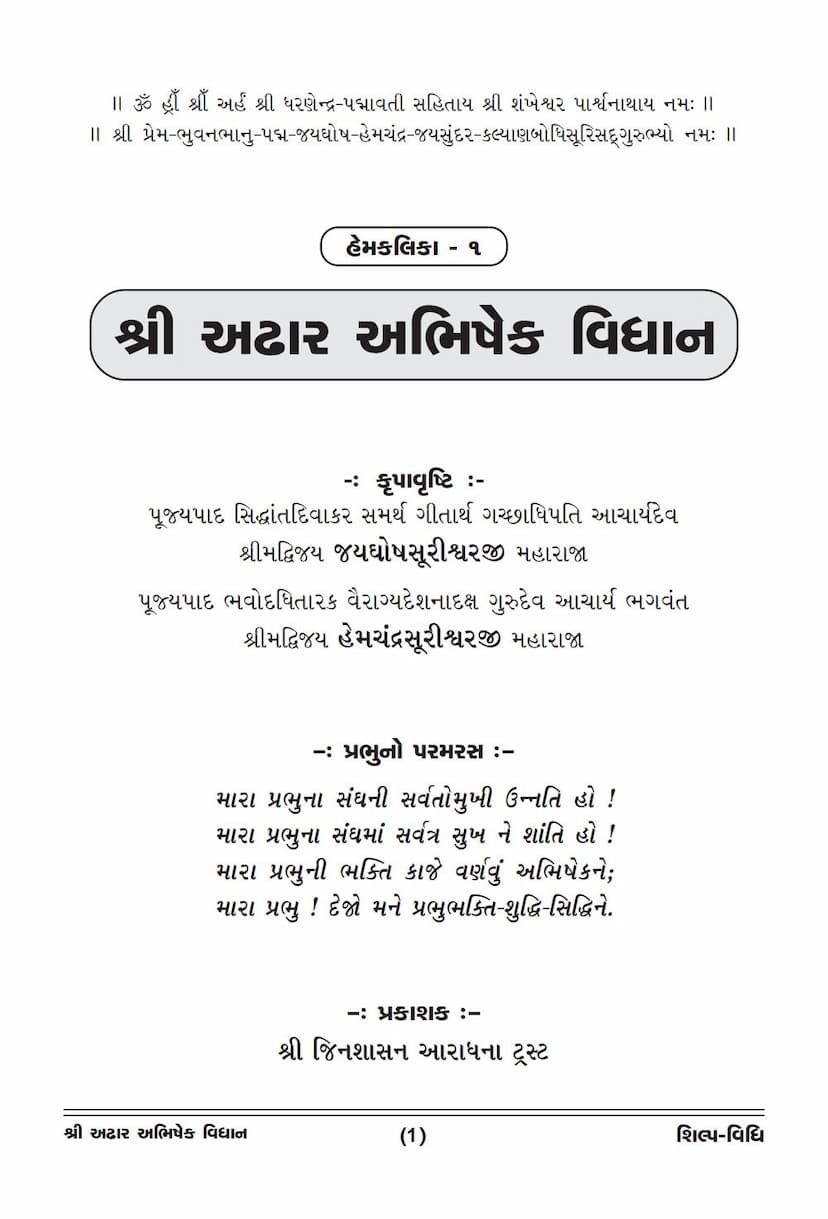Adhar Abhishek Vidhan
Added to library: September 1, 2025

Summary
Here's a comprehensive summary of the Jain text "Adhar Abhishek Vidhan" by Saumyaratnavijay, published by Jinshasan Aradhana Trust, based on the provided pages:
Book Title: Adhar Abhishek Vidhan (The Ritual of Eighteen Auspicious Baths) Author: Muni Saumyaratnavijayji Publisher: Jinshasan Aradhana Trust Series: Hemkalika - 1
Overview:
"Adhar Abhishek Vidhan" is a sacred Jain text dedicated to the ritualistic bathing (Abhishek) of the divine idols of the Tirthankaras. The book emphasizes that this ritual, while widely practiced, has evolved and has undergone variations from its ancient origins. This edition aims to present a purified, comprehensive, and devotional rendition of the eighteen types of Abhisheks, drawing from ancient manuscripts and scholarly consultations. The core purpose is to enhance the purity, glory, and spiritual significance of the Jina idols and the faith of the devotees.
Key Themes and Content:
-
Purpose of the Abhishek: The Abhishek ritual is performed for several reasons:
- To purify and enhance the splendor of the Jina idols and the temple (Jinmandir).
- To avert potential insults or transgressions (Ashata) against the divine.
- For general purification and to increase the divine presence and glory.
- It is often performed during consecrations (Pratishtha) and significant religious events.
-
Editorial Approach and Scholarly Basis:
- Compilation from Ancient Texts: The text is compiled based on twenty-three selected palm-leaf manuscripts and ancient texts related to consecration rituals.
- Emphasis on Authenticity: The editor, Muni Saumyaratnavijayji, along with consultations with learned scholars, Acharyas, and experienced ritualists (Vidhikarakas), has strived to adhere to the scriptural accuracy (Shastra Shuddh), ritualistic purity (Vidhi Shuddh), and devotional essence (Bhav Shuddh).
- Basis for the Current Edition: A primary reference for this edition is the "Pratishtha Kalpa" authored by Acharya Shri Senasurishwarji Maharaj, a prominent disciple of Jagadguru Acharya Shri Hirsurishwarji Maharaj.
- Addressing Variations: The book acknowledges discrepancies between ancient and currently practiced Abhishek procedures and aims to reconcile them through extensive research and discussion.
-
Structure of the Book: The book is divided into four main sections, reflecting different aspects of the Abhishek ritual:
- Section 1: Vidhan Saundarya (Beauty of the Ritual): This section provides the step-by-step ritualistic procedures from the initial purification to the final rituals. Each Abhishek is presented on a separate page, with explanations of its significance, inspiring meditative thoughts, and the accompanying mantras and verses with their meanings.
- Section 2: Shastra-Rahasya Saundarya (Beauty of Scriptural Secrets): This part delves into the deeper meanings and unique aspects of the eighteen Abhisheks, highlighting differences from current common practices. This includes details like applying pastes (Vilepan) before certain Abhisheks, specific invocation procedures (Aahvan Vidhan), offering (Argh Arpan), and the significance of mirror (Darpan) and moon-sun (Chandra-Surya) observations. It discusses the rationale behind these practices based on ancient texts.
- Section 3: Bhav Saundarya (Beauty of Devotion): This section focuses on cultivating devotional feelings (Bhav) during the ritual. It includes inspiring stories, scriptural references that enhance devotion, details about the properties of medicinal ingredients, the bhavanas (meditative reflections) to be held during each Abhishek, and motivational guidance.
- Section 4: Bhakti Saundarya (Beauty of Devotional Songs): This part compiles devotional songs, verses, and hymns (Stutis and Bhajans) related to the Abhishek. These are meant to be sung during the ritual to enhance the joyous and devotional atmosphere.
-
Key Ritualistic Elements:
- Preparation: The text details the essential preparations, including arranging sacred materials, lamps, incense, offering vessels, and ensuring the purity of the items used. It strongly advises against using inferior materials like plastic and recommends brass or copper utensils.
- Prohibited Actions (Ashata): A crucial part of the book lists actions to be strictly avoided during the Abhishek to prevent any insult to the divine. These range from dropping the idols to using impure materials or performing the ritual with improper demeanor.
- Precautions (Savadhani): Specific instructions are given on how to manage the ritualistic flow, such as collecting the Abhishek water, ensuring proper application of pastes, and the sequence of offerings.
- Medicinal Ingredients: The book details specific medicinal herbs and their uses in different Abhisheks, explaining their intended effects and spiritual significance. Examples include gold powder, five gems, various plant ashes, medicinal roots, and fragrant substances.
- Special Rituals: Specific rituals like "Aahvan Vidhan" (invocation), "Arth Arpan Vidhan" (offering of value/respect), and "Chandra-Surya Darshan" (viewing the moon and sun symbols) are explained in detail.
- Eightfold Worship (Ashtaprakari Puja): Following the main Abhisheks, the text describes the Ashtaprakari Puja (worship with eight types of offerings), including water, sandalwood paste, flowers, incense, lamps, unbroken rice, sweets, and fruits, along with their devotional significance and related verses.
- Final Rites: The ritual concludes with purification (Lun Utaran), Aarti, Mangal Deep (auspicious lamp), Shanti Kalash (peace-conferring pot), Chaitya Vandan, and finally, forgiveness (Kshamapan).
-
Spiritual and Philosophical Insights:
- "Shilpa" (Craftsmanship): The book uses the concept of "Shilpa" to represent the craftsmanship involved in rituals, inner development, and devotional expression. It differentiates between material craft (dravya shilpa), self-craft (atma shilpa), and devotional craft (bhav shilpa).
- Cultivating Devotion: The text consistently emphasizes the importance of pure intentions (Bhav) and heartfelt devotion (Bhakti) during the Abhishek, stating that these spiritual qualities are as crucial as the correct ritualistic procedures.
- Inner Transformation: Each Abhishek is linked to a specific "Bhavashilpa," encouraging devotees to reflect on virtues like equanimity, detachment, compassion, faith, and inner purity.
- Symbolic Meanings: The ingredients and actions in the Abhishek are imbued with symbolic meanings, relating to the purification of the soul, overcoming karmic obstacles, and achieving spiritual liberation.
Conclusion:
"Adhar Abhishek Vidhan" is presented as a guide to performing the eighteen auspicious baths with deep devotion and scriptural adherence. It aims to revive and standardize the practice, ensuring its spiritual efficacy and enriching the devotional experience of the Jain community. The book is a testament to the meticulous research and devotional commitment of the editor and publisher in preserving and propagating this significant Jain ritual.